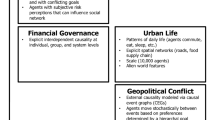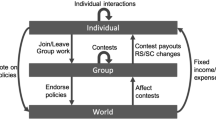Abstract
A scientific model’s usefulness relies on its ability to explain phenomena, predict how such phenomena will be impacted by future interventions, and prescribe actions to achieve desired outcomes. We study methods for learning causal models that explain the behaviors of simulated “human” populations. Through the Ground Truth project, we solved a series of Challenges where our explanations, predictions and prescriptions were scored against ground truth information. We describe the processes that emerged for applying causal discovery, network analysis, agent-based modeling and other analytical methods to inform solutions to Challenge tasks. We present our team’s overall performance results on these Challenges and discuss implications for future efforts to validate social scientific research using simulation-based challenges.















Similar content being viewed by others
Notes
ananke is shared at: https://gitlab.com/causal/ananke with documentation available at: https://ananke.readthedocs.io/en/latest/.
The graphml format is documented at http://graphml.graphdrawing.org/.
dworp is an open-source project available at https://pypi.org/project/dworp/.
References
Bhattacharya R, Malinsky D, Shpitser I (2019a) Causal inference under interference and network uncertainty. In: The 35th conference on uncertainty in artificial intelligence (UAI-19), AUAI Press
Bhattacharya R, Nabi R, Shpitser I, Robins JM (2019b) Identification in missing data models represented by directed acyclic graphs. In: The 35th conference on uncertainty in artificial intelligence (UAI-19), AUAI Press
Bhattacharya R, Nabi R, Shpitser I (2020) Semiparametric inference for causal effects in graphical models with hidden variables. arXiv:2003.12659 [stat.ML]
Dorie V, Hill J, Shalit U, Scott M, Cervone D (2019) Automated versus do-it-yourself methods for causal inference: lessons learned from a data analysis competition. Stat Sci 34(1):43–68
Fink C, Schmidt A, Barash V, Kelly J, Cameron CJ, Macy M (2016) Investigating the observability of complex contagion in empirical social networks. In: The international AAAI conference on web and social media (ICWSM), pp 335–348
Finkelstein N, Shpitser I (2020) Deriving bounds and inequality constraints using logical relations among counterfactuals. In: The 36th conference on uncertainty in artificial intelligence (UAI-20), AUAI Press
Glymour C, Zhang K, Spirtes P (2019) Review of causal discovery methods based on graphical models. Front Genet 10:524
Karavani E, El-Hay T, Shimoni Y, Yanover C et al (2019) Comment: causal inference competitions: where should we aim? Stat Sci 34(1):86–89
Laatabi A, Marilleau N, Nguyen-Huu T, Hbid H, Babram MA (2018) ODD+ 2D: an ODD based protocol for mapping data to empirical ABMS. J Artif Soc Soc Simul 21(2):9
Lee JJR, Shpitser I (2020) Identification methods with arbitrary interventional distributions as inputs. arXiv preprint, arXiv:200401157
Malinsky D, Danks D (2018) Causal discovery algorithms: a practical guide. Philos Compass 13(1):e12470
Malinsky D, Spirtes P (2018) Causal structure learning from multivariate time series in settings with unmeasured confounding. In: Proceedings of 2018 ACM SIGKDD workshop on causal discovery, pp 23–47
Müller B, Bohn F, Dreßler G, Groeneveld J, Klassert C, Martin R, Schlüter M, Schulze J, Weise H, Schwarz N (2013) Describing human decisions in agent-based models-ODD+ D, an extension of the odd protocol. Environ Model Softw 48:37–48
Nabi R, Bhattacharya R, Shpitser I (2020) Full law identification in graphical models of missing data: Completeness results. In: The thirty-seventh international conference on machine learning (ICML 2020), arXiv:2004.04872 [stat.ME]
Naugle A, Krofcheck D, Warrender C, Lakkaraju K, Swiler L, Verzi S, Emery B, Murdock J, Bernard M, Romero V (2020a) Results of the ground truth program: What can simulation test beds teach us about social science? Comput Math Organ Theory
Naugle A, Russell A, Lakkaraju K, Swiler L, Verzi S, Romero V (2020b) The ground truth program: simulations as test beds for social science research methods. Comput Math Organ Theory
Ogarrio JM, Spirtes P, Ramsey J (2016) A hybrid causal search algorithm for latent variable models. In: Conference on probabilistic graphical models, pp 368–379
Ogburn B, Lee Y, Shpitser I (2018) Causal inference, social networks, and chain graphs. J R Stat Soc A (to appear), arXiv:1812.04990 [stat.ME]
Parunak HVD (2020) SCAMP’s stigmergic model of social conflict. Comput Math Organ Theory
Pynadath DV, Dilkina B, Jeong DC, John RS, Marsella SC, Merchant C, Miller LC, Read SJ (2020) Disaster world: Decision-theoretic agents for simulating population responses to hurricanes. Comput Math Organ Theory
Rager S, Leung A, Pinegar S, Mangels J, Poole MS, Contractor N (2020) Groups, governance, and greed: The access world model. Comput Math Organ Theory
Richardson TS, Evans RJ, Robins JM, Shpitser I (2017) Nested markov properties for acyclic directed mixed graphs. In: The thirty-seventh international conference on machine learning (ICML 2020), arXiv:1701.06686 [stat.ME]
Robins J (1986) A new approach to causal inference in mortality studies with a sustained exposure period-application to control of the healthy worker survivor effect. Math Model 7(9–12):1393–1512
Shalizi CR, Thomas AC (2011) Homophily and contagion are generically confounded in observational social network studies. Sociological methods & research 40(2):211–239. https://doi.org/10.1177/0049124111404820
Sherman E, Shpitser I (2018) Identification and estimation of causal effects from dependent data. In: The 32nd annual conference on neural information processing systems (NeurIPS-18), AUAI Press
Sherman E, Shpitser I (2019) Intervening on network ties. In: The 35th conference on uncertainty in artificial intelligence (UAI-19), AUAI Press
Sherman E, Arbour D, Shpitser I (2020) General identification of dynamic treatment regimes under interference. In: Chiappa S, Calandra R (eds) the 23rd international conference on artificial intelligence and statistics (AISTATS), PMLR, proceedings of machine learning research, vol 108, pp 3917–3927
Shpitser I (2015) Segregated graphs and marginals of chain graph models. In: Advances in neural information processing systems, pp 1720–1728
Shpitser I, Pearl J (2008) Complete identification methods for the causal hierarchy. J Mach Learn Res 9(Sep):1941–1979
Shpitser I, Evans RJ, Richardson TS (2018) Acyclic linear sems obey the nested markov property. In: Conference on uncertainty in artificial intelligence, p 255
Spirtes P, Scheines R, Ramsey J, Glymour C (2009) Repository for the Tetrad Project. https://github.com/cmu-phil/tetrad, (version 6.7.0, Accessed 23 Sept 2019)
Tchetgen Tchetgen E, Fulcher I, Shpitser I (2017) Auto-g-computation of causal effects on a network. J Am Stat Assoc (to appear), arXiv:1709.01577 [stat.ME]
Tikka S, Karvanen J (2017) Identifying causal effects with the R package causaleffect. J Stat Softw 76(12):1–30, https://doi.org/10.18637/jss.v076.i12
Verma T, Pearl J (1990) Equivalence and synthesis of causal models [technical report r-150]. University of California, Los Angeles, Department of Computer Science
Züfle A, Wenk C, Pfoser D, Crooks A, Kavak H, Kim JS, Jin H (2020) Urban life: a model of people and places. Comput Math Organ Theory
Acknowledgements
This project is sponsored by the Defense Advanced Research Projects Agency (DARPA) under contract HR0011-18-C-0049. The content of the information does not necessarily reflect the position or the policy of the Government, and no official endorsement should be inferred.
Author information
Authors and Affiliations
Corresponding author
Additional information
Publisher's Note
Springer Nature remains neutral with regard to jurisdictional claims in published maps and institutional affiliations.
Rights and permissions
About this article
Cite this article
Schmidt, A.C., Cameron, C.J., Lowman, C. et al. Searching for explanations: testing social scientific methods in synthetic ground-truthed worlds. Comput Math Organ Theory 29, 156–187 (2023). https://doi.org/10.1007/s10588-021-09353-w
Accepted:
Published:
Issue Date:
DOI: https://doi.org/10.1007/s10588-021-09353-w




